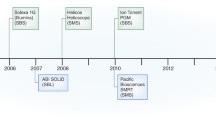Abstract
DNA sequencing is one of the most important techniques in molecular biology, and over the last decades it has enabled tremendous insights into nearly all aspects of life sciences and medicine. Here, we present a brief historical overview of the development of DNA sequencing from the now classical Maxam-Gilbert and Sanger techniques to the latest next generation sequencing (NGS).
Similar content being viewed by others
Literatur
Wu R, Kaiser AD (1968) Structure and base sequence in the cohesive ends of bacteriophage lambda DNA. J Mol Biol 35:523–537
Sanger F, Nicklen S, Coulson AR (1977) DNA sequencing with chain-terminating inhibitors. Proc Natl Acad Sci USA 74:5463–5467
Maxam AM, Gilbert W (1977) A new method for sequencing DNA. Proc Natl Acad Sci USA 74:560–564
Messing J, Gronenborn B, Müller-Hill B et al. (1977) Filamentous coliphage M13 as a cloning vehicle: insertion of a HindII fragment of the lac regulatory region in M13 replicative form in vitro. Proc Natl Acad Sci USA 74:3642–3646
Vieira J, Messing J (1982) The pUC plasmids, an M13mp7-derived system for insertion mutagenesis and sequencing with synthetic universal primers. Gene 19:259–268
Sanger F, Donelson JE, Coulson AR et al. (1973) Use of DNA polymerase I primed by a synthetic oligonucleotide to determine a nucleotide sequence in phage fl DNA. Proc Natl Acad Sci USA 70:1209–1213
Goffeau A, Barrell BG, Bussey H et al. (1996) Life with 6000 genes. Science 274:546, 563–567
Fleischmann RD, Adams MD, White O et al. (1995) Wholegenome random sequencing and assembly of Haemophilus influenzae Rd. Science 269:496–512
Margulies M, Egholm M, Altman WE et al. (2005) Genome sequencing in microfabricated high-density picolitre reactors. Nature 437:376–380
Bentley DR, Balasubramanian S, Swerdlow HP et al. (2008) Accurate whole human genome sequencing using reversible terminator chemistry. Nature 456:53–59
Li R, Fan W, Tian G et al. (2010) The sequence and de novo assembly of the giant panda genome. Nature 463:311–317
Nowrousian M, Stajich JE, Chu M et al. (2010) De novo assembly of a 40 Mb eukaryotic genome from short sequence reads: Sordaria macrospora, a model organism for fungal morphogenesis. PLoS Genet 6:e1000891
Author information
Authors and Affiliations
Corresponding author
Rights and permissions
About this article
Cite this article
Kück, U., Nowrousian, M. Von Maxam-Gilbert und Sanger zur Next Generation-Sequenzierung. Biospektrum 21, 25–27 (2015). https://doi.org/10.1007/s12268-015-0529-3
Published:
Issue Date:
DOI: https://doi.org/10.1007/s12268-015-0529-3




